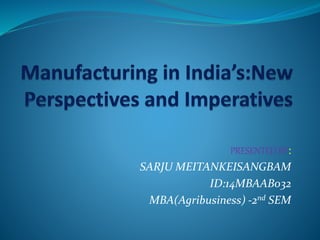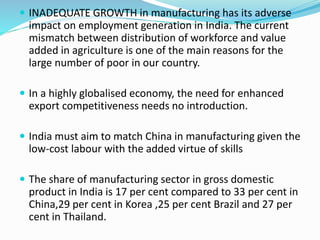Manufacturing in Indiaﻗs.pptx 1
- 2. ﺅ INADEQUATE GROWTH in manufacturing has its adverse impact on employment generation in India. The current mismatch between distribution of workforce and value added in agriculture is one of the main reasons for the large number of poor in our country. ﺅ In a highly globalised economy, the need for enhanced export competitiveness needs no introduction. ﺅ India must aim to match China in manufacturing given the low-cost labour with the added virtue of skills ﺅ The share of manufacturing sector in gross domestic product in India is 17 per cent compared to 33 per cent in China,29 per cent in Korea ,25 per cent Brazil and 27 per cent in Thailand.
- 4. ﺅ However , we are short in other resources and infrastructure that investors seek , a weakness that has checked the flow of investments into skill-intensive manufacturing. ﺅ Recent trends in some sectors , such as auto and auto components, speciality chemicals, generic drugs and engingeering,however , suggest a vast scope for global manufactures to locate here. ﺅ The policy thrust outlined by the Prime Minister through the two flagship programmes, ﻗ Make in Indiaﻗ and ﻗSkill Indiaﻗ ,should be understood against this background.
- 6. The Need for ﻗMake In Indiaﻗ ﻗMake in Indiaﻗ is a timely policy initiative to convert India into a global manufacturing hub. In order to attract new investments and promote manufacturing ,this programme addresses the problem areas in the manufacturing sector through different channel of interventions include a the E-Biz portal ending 24*7 applications of industrial license making the process seamless . The policy has given approval to National Investment and Manufacturing Zones, wherein , the provision for single window clearance will be provided.
- 7. The Need for ﻗSkill Indiaﻗ ﺅ The Modi government launched a new skill development policy by March 2015 that would bridge the gap between educational institutions and the labour market, minister of state for skill development and entrepreneurship Sarbananda Sonowal said. ﺅ The new scheme is expected to move beyond the target of skilling 500 million youth by 2020 that was set by the UPA government. ﺅ A multi skill development programme on mission mode for job creation and entrepreneurship for all socio-economic classes is being worked out. This will facilitate mobility of workforce.
- 8. Role of MSME in ﻗMake In Indiaﻗ ﺅ MSMEs can play a critical role to strengthen the ﻗMake In Indiaﻗ initiative by addressing the issues of job creation , increasing the manufacturing share in GDP and export promotion . Already , the sector contributes to around 45 per cent of the total manufacturing output and around 40 per cent of the countryﻗs exports. ﺅ There has been a sustained contribution of the MSME both in terms of output and employment , inspite of the slowdown in the economy as a whole and the manufacturing sector in particular.
- 9. ﺅ And worryingly, it is losing depth . While Chinaﻗs GDP is 3.8 times larger than Indiaﻗs , its production of machine tools , the ﻗMother Industryﻗ of manufacturing , is 55 times more ! India needs a strategy to grow manufacturing 12 per cent to 14 per cent annum , create 100 million new manufacturing jobs in the next 15 years to realize itsﻗ Demographic Dividendﻗ , and create more depth in capital goods industries and innovation for its manufacturing sector to be competitive and sustainable.
- 10. Manufacturing Competitiveness : Meaning and Coverage. ﺅ Competitive economies are those that have in place factors, driving the productivity enhancements on which their present and future prosperity is built. ﺅ The World Economic Forum(WEF) defines competitiveness as the set of institutions, policies , and factors that determine the level of productivity of a country.
- 11. Enterprise Size and Competitiveness Naturally, the academic discourse on manufacturing has significantly created a hegemony, wherein, the roles of small and medium enterprises was relegated to the background. , that helped to shift the attention more towards the MSMEs ﻗ۱ According to international statistics , over 50 per cent of small business fail year and 95 per cent fail within the first five years. Apart from the usual causes of business failure like inexperienced entrepreneurs , poor locations and lack of capital for growth , another reason is complacency. ﻗ۱ Manufacturing competitiveness , in the modern world, need to be discussed in relation to the process of globalization ,and liberalization of the economy.
- 12. Manufacturing Competitiveness : issues ﺅ Technology and Innovation Enhancement. ﺅ Initiatives on Skill Upgradation. ﺅ Entrepreneurship Policy. ﺅ Development of Knowledge Systems ﺅ1. Knowledge Generation and Acquisition : This happens through scientific discovery , R&D, transfer of tech. , organization , and cultural practices. ﺅ2. Knowledge Adaptation : This should happen through innovation to particular fields , needs and operating environment.
- 13. Role of infrastructure ﺅ A modern , well-organized and widespread infrastructure is a pre requisite for a countryﻗs economic growth. Ministry of Finance estimates that infrastructure projects of approx INR 1 lakh crore have been delayed.Time and cost overruns in implementation of projects continue to be one of the main reasons for under-achievement of the sector. ﺅ Manufacturing sector which has seen a significant slowdown over the past few years need to increase its share of GDP from 15 per cent to 25 per cent . ﺅ Given the above , the new Govt. has ,over the last couple of months , identified infrastructure development and growth in manufacturing sector as its key focus areas.
- 14. ﺅ I n China, manufacturing policies are framed to strengthen domestically owned and managed capabilities . In fact, the Chinese government is framing IPR rules to further its own interests , suspecting that the rules being imposed on it have been devised principally to protect foreign companiesﻗ interests. China is using the lever of purchases by govt. agencies to develop indigenous tech. ﺅ While attracting foreign investments and new technologies from board is crucial , they must result in jobs, innovations, and manufacturing depth in India. The time has come for Indian Policymakers to sharpen the national manufacturing strategy , on the basis of the more recent evidences on the changes in the global economy , vis -a- vis Indiaﻗs comparative position . The sustainability of India ﻗs growth story depends on it.
- 15. The Way Forward ﺅ Given the importance of infrastructure development and manufacturing the Govt. can play a key role of a catalyst in kick-starting growth in the sectors . The Union Budget 2015 has taken some steps to put the economy back on high growth trajectory.
- 16. You
















